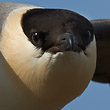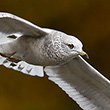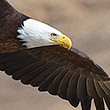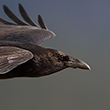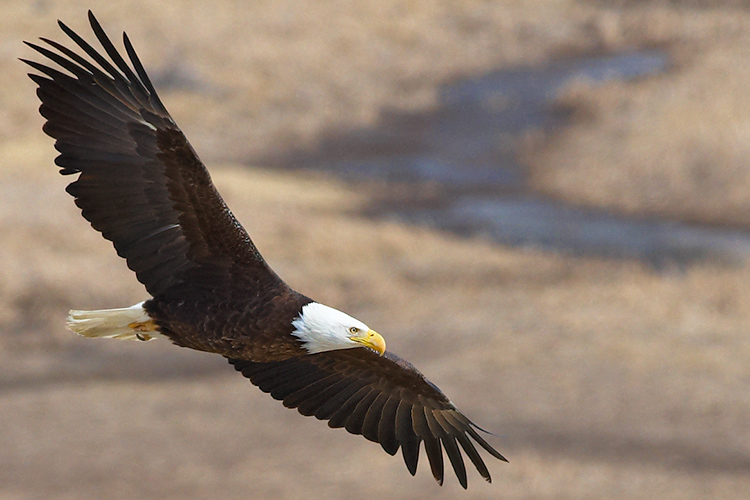
Availability: Undetermined - Enquiries?
In the Field
Policing the Wetlands. Columbia Valley Wetlands, BC, Canada. March 28, 2008
Bald Eagles have been slow to return to BC's Columbia Valley this year. In most years by mid March large numbers of migrating eagles have arrived in our area and begun a short stop-over. But this year the birds have been arriving in dribs and drabs and it was only a few days ago that they began to congregate in numbers. Behind schedule...but still very majestic!
The area I have chosen as my primary shooting location is ideally suited for mid to late afternoon shooting sessions. It's located on top of a cliff of about 200 feet with the broad wetlands of the Columbia Valley directly below. The eagles often soar along the cliff face, thus giving me a chance to photograph the birds at eye level (as opposed to shooting up into the sky). In some situations (like when I captured this shot) I'm even able to shoot slightly DOWN at the soaring birds, which is a reasonably uncommon (but very appealing) situation. The bird in this photo had been sitting on the ice in the wetlands when it suddenly took off and did a lazy circuit of the valley, almost as though it was doing a quick check to make sure all was as it should be! Moments after I shot this image the bird settled back on the ice.
Behind the Camera
Policing the Wetlands. Columbia Valley Wetlands, BC, Canada. March 28, 2008
Digital Capture; Compressed RAW (NEF) 14-bit format; ISO 800.
Nikon D3 with Nikon 300mm f/2.8G ED-IF AF-S VR lens with Nikon TC-14E11 1.4x teleconverter (420 mm equivalent) - handheld. VR turned to "On" and in "Normal" mode.
1/1600s @ f8; -0.3 stop compensation from matrix-metered exposure setting.
At the Computer
Policing the Wetlands. Columbia Valley Wetlands, BC, Canada. March 28, 2008
RAW Conversion to 16 bit TIFF, including first-pass/capture sharpening, exposure compensation, and slight shadow/highlight adjustment using Phase One's Capture One 4.
Further digital correction on 16-bit TIFF file using Adobe's Photoshop CS3. Photoshop adjustments included selective curves adjustment, selective saturation enhancement and selective sharpening for web output.
Conservation
Policing the Wetlands. Columbia Valley Wetlands, BC, Canada. March 28, 2008
Ten percent of the revenue generated by this image will be donated to Wildsight.
Species Status in Canada*: This species is not designated as at risk. The Bald Eagle was listed as "Endangered" in the contiguous US states from 1967 to 1995. In 1995 it was downlisted to "Threatened". On June 28, 2007 Bald Eagles were removed from the list of endangered and threatened species - a true American conservation success story.
The Bald Eagle (Haliaeetus leucocephalus) is a very large bird of prey with broad wings. Adults possess characteristic white ("bald") heads. It takes Bald Eagles a full five years to attain their characteristic adult plumage (including their nearly pure white head and tail). In the years prior to the development of their adult plumage they are easy to confuse with Golden Eagles. Being very broad-winged Bald Eagles are able to use an energy-efficient flapping-soaring style of flight. While many people like to think of the Bald Eagle as a fierce hunter, in reality they hunt only as a last resort. More commonly they scavenge for their prey. Additionally, they often klepto-parasitize other weaker species such as Osprey, commonly stealing the other species hard-earned prey items. The Bald Eagle is, of course, the national emblem of the United States (Benjamin Franklin argued against this - his preference was for the Wild Turkey).
This Bald Eagle was photographed in the Columbia Valley of the East Kootenays. While Bald Eagles are currently not under the threat of extinction, they do, of course, require suitable breeding habitat to continue to thrive. Many ecosystems - including Bald Eagle breeding areas - within the Columbia Valley face development pressure, including pressure from both logging operations and human population growth. Wildsight is an effective conservation organization that protects biodiversity and promotes sustainable communities in Canada's Columbia and Rocky Mountains. Support for Wildsight, through donation or becoming a member, will help ensure that they remain effective in their efforts to conserve threatened or endangered species and ecosystems.
*as determined by COSEWIC: The Committee on the Status of Endangered Wildlife in Canada





















